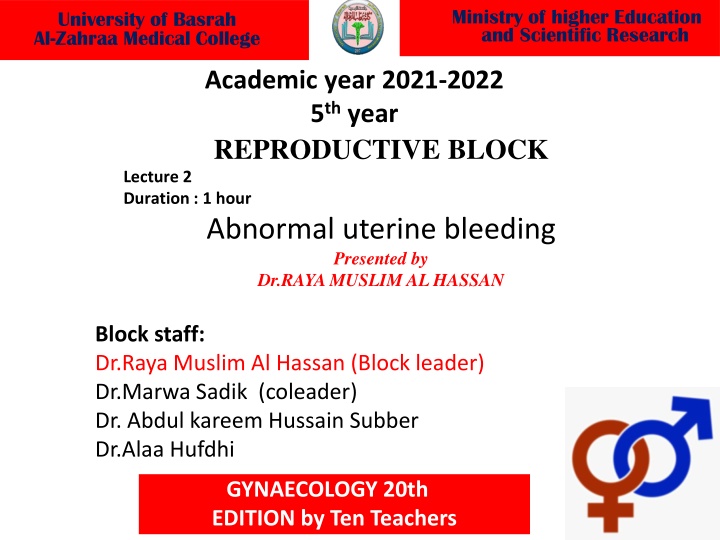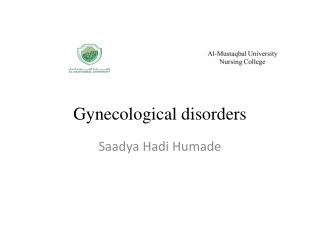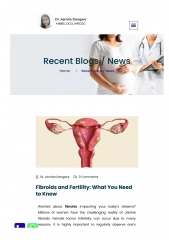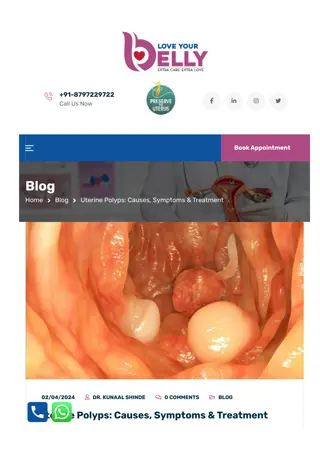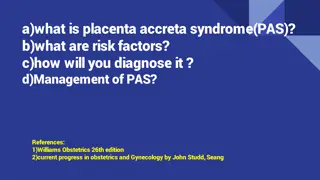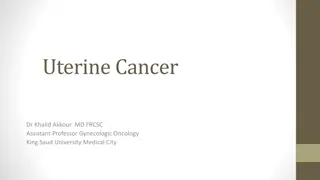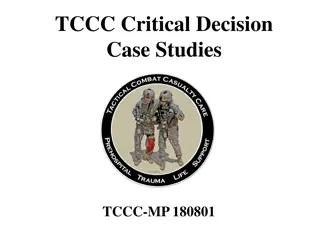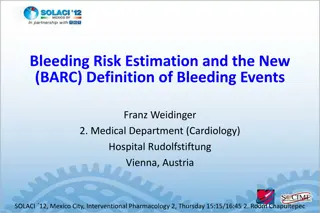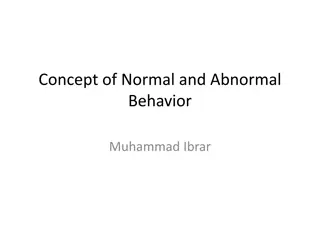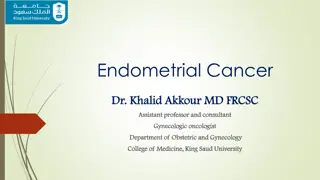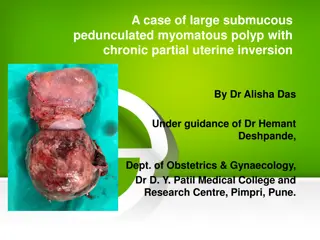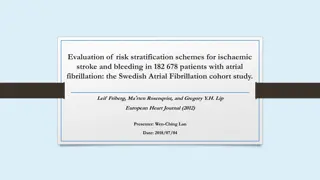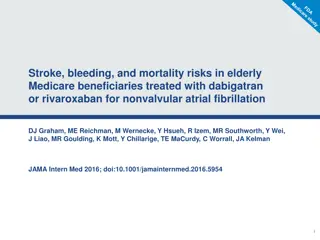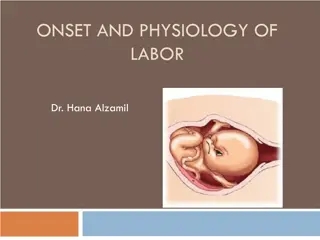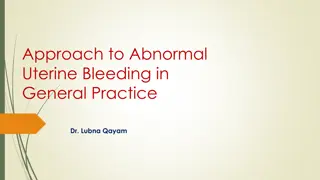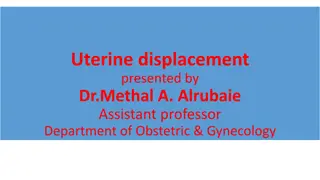Abnormal Uterine Bleeding: Clinical Patterns & Etiology
Abnormal uterine bleeding is any deviation from normal menstrual flow. Learn about its classification, causes, and evaluation methods to provide effective medical care. Explore the characteristics of normal menstrual cycles and the impact of Heavy Menstrual Bleeding (HMB) on women's well-being. Gain insights into distinguishing between organic and non-organic causes of abnormal uterine bleeding, enhancing diagnostic accuracy and treatment strategies.
Download Presentation

Please find below an Image/Link to download the presentation.
The content on the website is provided AS IS for your information and personal use only. It may not be sold, licensed, or shared on other websites without obtaining consent from the author.If you encounter any issues during the download, it is possible that the publisher has removed the file from their server.
You are allowed to download the files provided on this website for personal or commercial use, subject to the condition that they are used lawfully. All files are the property of their respective owners.
The content on the website is provided AS IS for your information and personal use only. It may not be sold, licensed, or shared on other websites without obtaining consent from the author.
E N D
Presentation Transcript
Ministry of higher Education and Scientific Research University of Basrah Al-Zahraa Medical College Academic year 2021-2022 5th year REPRODUCTIVE BLOCK Lecture 2 Duration : 1 hour Abnormal uterine bleeding Presented by Dr.RAYA MUSLIM AL HASSAN Block staff: Dr.Raya Muslim Al Hassan (Block leader) Dr.Marwa Sadik (coleader) Dr. Abdul kareem Hussain Subber Dr.Alaa Hufdhi Dr. Luma Zeiny GYNAECOLOGY 20th EDITION by Ten Teachers
Ministry of higher Education and Scientific Research University of Basrah Al-Zahraa Medical College Objectives: Define abnormal uterine bleeding & classical terms applied to its clinical patterns. Outline the etiology. Discuss how to evaluate abnormal uterine bleeding.
Ministry of higher Education and Scientific Research University of Basrah Al-Zahraa Medical College Abnormal uterine bleeding: is defined as any alteration in the normal pattern of menstrual flow. Characteristics of the normal menstrual cycle: Average length 28 days ( 21-35 days). Average duration 4 days (1-8 days). Amount 35 ml (< 80 ml*)
Ministry of higher Education and Scientific Research University of Basrah Al-Zahraa Medical College HMB: excessive menstrual blood loss (PREVIOUSLY called menorrhagia). IMB: bleeding between periods,. PCB: bleeding after sex. PMB: bleeding more than 1 year after cessation of periods. BEO: bleeding of endometrial origin , a diagnosis of exclusion, has replaced the term dysfunctional uterine bleeding (DUB).
Ministry of higher Education and Scientific Research University of Basrah Al-Zahraa Medical College Heavy Menstrual Bleeding (HMB) Heavy menstrual bleeding (HMB) is now the preferred description & replaces the older term menorrhagia For clinical purposes, HMB should be defined as excessive menstrual blood loss which interferes with the woman's physical, emotional, social and the quality of life, and which can occur alone or in combination with other symptoms. Any interventions should aim to improve quality of life measures rather than focusing on measuring the blood loss.
Ministry of higher Education and Scientific Research University of Basrah Al-Zahraa Medical College Aetiology Abnormal uterine bleeding classified into : 1)Organic. 2)Non-organic (BEO).
Ministry of higher Education and Scientific Research University of Basrah Al-Zahraa Medical College NON ORGANIC(BEO): -no identifiable organic cause ;genital or extragenital. -it is a dx of exclusion. -It is classified into ovulatory & anovulatory a)Ovulatory BEO: -age 35-45 yr. -Regular, heavy & often painful menstrual periods. -Ther may be inadequate progesterone production or altered life span of corpus luteum. -occurs in most cases of HMB in which there may be disordered endometrial prostagladins production.
Ministry of higher Education and Scientific Research University of Basrah Al-Zahraa Medical College b)Anovulatory BEO ( >85%): -There is continuous E2 production & endometrial proliferation without corpus luteum formation & progesterone production. - Commonly occurs at extremes of reproductive age. In perimenarchal adolescents,it is due to immaturity of hypothalamo-pituitary ovarian axis.The axis is unable to respond to E2 with an LH surge. In perimenopausal women it is due to declining ovarian function. -Usually irregular. - More common in obese women ( peripheral conversion of ESTrogen to esterone).
Ministry of higher Education and Scientific Research University of Basrah Al-Zahraa Medical College Organic causes of Abn.UB 1) Pregnancy-related: Miscarriage Ectopic pregnancy GTD PPH 2) Infection : Cervicitis Endometritis PID 3)Endometriosis & adenomyosis.
Ministry of higher Education and Scientific Research University of Basrah Al-Zahraa Medical College 4) Neoplasm: Cervical dysplasia/polyp/ca Endometrial hyperplasia/ca Leiomyoma especially submucous Esterogen-producing ovarian tumor 5) Systemic: Thyroid disorders (hypo- or hyperthyroidism). DM Prolactin disorders Adrenal disorders Liver dis. Renal dis. Coagulation disorders (vwf deficiency, ITP,lukemia) Sepsis
Ministry of higher Education and Scientific Research University of Basrah Al-Zahraa Medical College 6) Iatrogenic: Oral contraceptive pills IUCD HRT Steroids Anticoagulants 7)Trauma & foreign bodies.
Ministry of higher Education and Scientific Research University of Basrah Al-Zahraa Medical College Evaluation: History: Detailed hx of pattern of menstrual bleeding guides further evaluation: Regularity,Frequency, duration & amount. Postcoital or intermenstrual bleeding denotes serious pathology. Actual blood loss is highly subjective but a rough idea may be gained from: 1. Number of pads/tampons & frequency of change. 2. Number of days of flow. 3. Clots or flooding. 4. Impact on quality of life.
Ministry of higher Education and Scientific Research University of Basrah Al-Zahraa Medical College Age, parity & marrital status. Symptoms of pregnancy. Symptoms of reproductive tract dis.(Dysmenorrhea, dyspareunia, pelvic pain &/or pressure symptoms ). Abdominal bloating & breast tenderness. Hx of unusual bleeding from gums, easy bruising & prolonged bleeding after minor cuts. Wt gain, constipation, fatigue, hair loss & edema. Galactorrhoea.. Drugs hx. POHX, PGHX & cervical smear, contraception & sexual hx PSHS & PMHX :associated comorbidities. GIT or urinary tract bleeding should be ruled out.
Ministry of higher Education and Scientific Research University of Basrah Al-Zahraa Medical College EXAMINATION EXAMINATION Vital signs. Height & weight. Tanner s staging of breast, axillary & pubic hair. Ecchymoses & petechiae. Hirsutism, skin pigmentation, striae, thyroid enlargement or nodularity. Abdominal palpation for liver enlargement, pelvic masses & regional lymphadenopathy. PR if GIT bleeding is suspected.
Ministry of higher Education and Scientific Research University of Basrah Al-Zahraa Medical College Pelvic examination Pelvic examination: : A physical examination should be carried out before : 1. LNG-IUS fittings. 2. investigations for structural abnormalities 3. investigations for histological abnormalities. Vulval inspection & speculum examination of vagina & cervix, if appropriate, for external evidence of bleeding, foreign body, trauma or signs of local disease e.g. vaginal atrophy, cerrvical erosion, polyp or ca. Vaginal/cervical swabs & pap smear if clinically indicated. Bimanual examination to assess uterine size, symmetry, adenexal mass & tenderness if appropriate.
Ministry of higher Education and Scientific Research University of Basrah Al-Zahraa Medical College LAB. Tests: LAB. Tests: Patient s HX & EX guide selection of various tests Patient s HX & EX guide selection of various tests. -HCG if any possibility of pregnancy exists. Full blood count should be carried out on all women with HMB. A serum ferritin test should NOT routinely be carried out on women with HMB Coagulation profile: (e.g, von Willebrand disease) should be considered in women who have had HMB since menarche & have personal or family history suggesting a coagulation disorder. TFT: only if other signs & symptoms of thyroid disease are present Female hormone testing (prolactin, FSH, LH, E2 & mid-luteal progesterones) should NOT be carried out on women with HMB. Serum androstendione) if there are signs of hyperandrogenism. LFT & RFT in systemic dis or malignancy. androgens (testosterone, DHEA-S, SHBG,
Ministry of higher Education and Scientific Research University of Basrah Al-Zahraa Medical College Structural & histological IXs Structural & histological IXs Indication of Imaging Indication of Imaging should be undertaken in the following circumstances: The uterus is palpable abdominally. Vaginal examination reveals a pelvic mass of uncertain origin. Medical treatment fails.
Ministry of higher Education and Scientific Research University of Basrah Al-Zahraa Medical College Imaging: 1. Ultrasound: is the first-line diagnostic tool for identifying structural abnormalities (measures endometrial thickness & diagnoses polyps, leiomyomata, areas of adenomyosis & polycystic ovaries). Colour information about pelvic vascularity flow Doppler provides 2. Saline infusion sonography (SIS): should not be used as a first-line diagnostic tool 3. CT/ MRI: should not be used as a first-line diagnostic tool, more invasive, used when better delineation of pelvic structures is needed.
TVS & SIS TVS SIS
Ministry of higher Education and Scientific Research University of Basrah Al-Zahraa Medical College Endometrial sampling: If appropriate, a biopsy should be taken to exclude endometrial cancer or atypical hyperplasia. Indications for a biopsy include irregular bleeding or persistent intermenstrual bleeding women aged 45 & over treatment failure
Ministry of higher Education and Scientific Research University of Basrah Al-Zahraa Medical College Methods of endometrial sampling: 1. Aspiration techniques (Pipelle): rapid outpatient screening test with limited sensitivity. 2.Dilatation & curettage (D&C):in this traditional blind procedure only about 50% of endometrium is sampled.
Ministry of higher Education and Scientific Research University of Basrah Al-Zahraa Medical College Endometrial Biopsy (EMB) Endometrial Biopsy (EMB) Evaluation of the Endometrium Pipelle
Ministry of higher Education and Scientific Research University of Basrah Al-Zahraa Medical College 3. Hysteroscopy: is the gold standard procedure as it provides visualization of entire endometrial cavity& allows specifically- directed biopsy. It is ideally performed in the proliferative phase where endometrium is at its thinnest.
Ministry of higher Education and Scientific Research University of Basrah Al-Zahraa Medical College TREATMENT TREATMENT 1.Medical; Hormonal:mirena pills Non hormonal: NSAID Antifibrinolytic 2.Surgical according to the cause
Ministry of higher Education and Scientific Research University of Basrah Al-Zahraa Medical College Readings Readings 1. Gynaecology by Ten Teachers, 20th Edition Ash Monga, Stephen Dobbs 2. Nice guidance 44, heavy menstrual bleeding
